Teranex Mini SDI to DisplayPort 8K HDR is an advanced 8K DisplayPort monitoring solution with dual on screen scope overlays, HDR, 33 point 3D LUTs and monitor calibration that’s been specifically designed for the professional film and television market and to take advantage of a new generation of monitors such as the Pro Display XDR.
Teranex Mini SDI to DisplayPort 8K HDR is an advanced 8K monitoring solution for DisplayPort computer displays or high quality monitors such as the new Pro Display XDR. Unlike basic converters, Teranex Mini SDI to DisplayPort 8K HDR can use third party calibration probes to accurately align connected displays for precise color. There's even 2 on-screen scopes that can be selected between WFM, Parade, Vector and Histogram. Teranex Mini SDI to DisplayPort 8K HDR is perfect for film studios and broadcasters who need professional but affordable color accurate monitoring. Customers also get an elegant design with color LCD for monitoring and control of settings.
The front panel includes controls and a color display for input video, audio meters and the video standard indicator. The rear panel has Quad Link 12G-SDI for HD, Ultra HD as well as 8K formats. There's 2 DisplayPort connections for regular computer monitors or USB-C style DisplayPort monitors such as the new Pro Display XDR. The built in scaler will ensure the video input standard is scaled to the native resolution of the connected DisplayPort monitor. Customers can even connect both 2SI or Square Division inputs.
Teranex Mini SDI to DisplayPort 8K HDR has everything for the latest HDR workflows. All that’s required is to connect a HDR compatible DisplayPort monitor to allow HDR SDI monitoring. Static metadata PQ and Hybrid Log Gamma (HLG) formats in the VPID are handled according to the ST2108-1, ST2084 and the ST425 standards. Teranex Mini SDI to DisplayPort 8K HDR handles ST425 which defines 2 new bits in the VPID to indicate transfer characteristic of SDR, HLG or PQ. Plus the ST2108-1 standard defines how to transport HDR static or dynamic metadata over SDI. Plus there is support for ST2082-10 for 12G SDI as well as ST425 for 3G-SDI sources. Both Rec.2020 and Rec.709 colorspaces are supported and 100% of the DCI-P3 format.
Two fully independent on screen scopes are included so compliance with broadcast standards is easy when doing critical high end work. Scopes are overlaid on screen so they can customize position, size and opacity. Customers can select from a range of scopes, including waveform for displaying luminance levels of their input signal. The vectorscope display allows customers to see the intensity of color at 100% SDI reference levels. Customers also get RGB and YUV parade displays, which are ideal for color correction and checking for illegal levels. Histogram shows the distribution of white to black detail in their images and highlights or shadows clipping.
Teranex Mini SDI to DisplayPort 8K HDR includes the same high quality 33 point 3D LUTs as used in the film industry. It's even possible to calibrate the connected display by connecting a third party USB color probe and Teranex Mini SDI to DisplayPort 8K HDR will analyze the monitor and generate a 3D LUT to correct for color differences between displays. Two independent 3D LUTs can be loaded and customers can select between them from the front panel.
It’s always difficult to know if a monitor is the correct color because every display is slightly different, even between the same model. Teranex Mini SDI to DisplayPort 8K HDR solves this problem as it can use a third party USB probe for automatically aligning their monitor. SpectraCal C6, X-Rite i1 Display Pro or the Klein K10-A probes are supported and plug into the front of the converter. The converter takes care of all the work and will automatically generate test signals on the monitor during the calibration process.
All Quad Link 12G-SDI inputs have outputs for looping to other equipment. Plus all HD, Ultra HD and 8K standards are supported allowing broadcast or film industry use. In 720p customers get support for 50p, 59.94p up to 60p. In 1080i formats, they get 50i, 59.94i up to 60i. 1080p, 1080PsF as well as 2160p formats are supported from 23.98 to 60 fps. Customers even get support for 2K and 4K DCI film formats from 23.98p to 60p. 4320p 8K formats are supported at 23.98, 24, 25, 29.97, 50, up to 59.94. With 2SI to Square Division conversion built in, an 8K source will be automatically converted for the monitor. Teranex Mini SDI to DisplayPort 8K HDR even handles both Level A or B 3G-SDI plus YUV and RGB SDI formats.
The front panel LCD provides confidence monitoring with both images and accurate audio level meters. There are menus for all functions and it’s easy to scroll through menu "pages" to find settings that need changing. The 3D LUTs can be enabled just by pressing the 1 or 2 buttons. Calibration is also started via the menus and customers simply follow the prompts to calibrate their display. The audio meters can even be switched between VU or PPM ballistics. There are settings for configuring scopes, their on screen location or opacity. Customers can even view and edit network settings.
For rack mounting, customers can simply add a Teranex Mini Rack Shelf. This consists of a metal tray that holds the converter and allows it to be screwed down before the whole shelf is bolted into the rack. Of course Teranex Mini SDI to DisplayPort 8K HDR includes rubber feet that customers can attach to the underside of the converter if customers want to place it on a desktop.







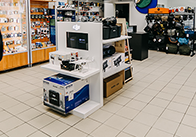
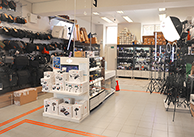
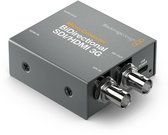



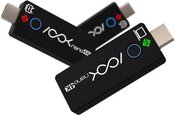
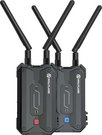
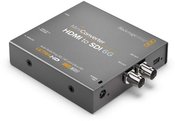
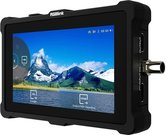











Atsiliepimai
0 vidutinis įvertinimas (0 įvertinimų)